This summer heat can be quite oppressive, but you shouldn’t let it keep you from getting outside and hiking! Hot temperatures can be a danger, but only if you are unprepared. Read about some tips and accessories that can help make your summer hiking a safe and fun experience for you and your family!
1– Hydrate, hydrate, hydrate. We all know how important staying hydrated it, but we want to emphasize it once more. One of the largest concerns in the summer is dehydration. While it’s a good idea to drink a lot of water every day, be especially diligent the day before you know you’ll be hiking in the heat! You don’t want to start your summer hike with your body already in a state of depletion. Dehydration can leave you feeling nauseous and with a headache and some dizziness. We can avoid this best by drinking plenty of water before even starting.
During your hike, be sure that you have prepared by bringing lots of water, or other hydration with electrolytes. At most, the human body can absorb 1 liter of water per hour, so do not be shy with drinking water. As you are hiking and sweating, you are not only losing water content but you also lose important minerals and electrolytes. If you plan to be out hiking all day, it can be a good idea to take electrolyte supplements and salt along with water to maintain a healthy balance in your hydration goals.
If you are going to be out for a very long summer hike, you can carry water treatment options like a water filter or purification tablets. These options can be useful if you run out of water and are near a water source like a stream or a river. Ideally, you’d drink water from a known, clean source but out of necessity, you can drink water from the wilderness after filtering it or treating it with purification.
2–Wear light, loose, sweat-wicking clothes, and avoid cotton. Your clothing choices are important for both comfort and function. You will want to choose light colored clothes (such as tan or khaki), which will reflect the suns rays away from your body. You also might want to consider clothing that has zipper vents, so that your body can feel cool air move through without trapping air along your skin.
Finally, many hikers tend to avoid cotton year round. Cotton does not wick sweat away from your body like many tech shirts and pants do. In the summer, cotton clothes that retain moisture might feel a little cooler, but it can also lead to issues like painful chafing. If you plan on hiking into the evening or night, avoid cotton. When the temperatures dip as the sun disappears, you will feel very cold very quickly which can be dangerous to your core temperature.
3–Wear a hat & sunscreen. Wearing a hat is not only highly fashionable, but it will also protect the sensitive skin on your face and neck from the suns dangerous UV rays. The hat should have a brim that covers your face, a trucker hat will suffice but a larger sunhat or wide brim hat will be better. Get high SPF sunscreen for your arms, neck, legs, or any exposed skin. Be sure to reapply as needed.
4–Start your hike early. The earlier you hit the trail, the more time hiking in cooler temperatures you’ll have. The hottest time of the day is in the afternoon, typically around 3pm. If you can complete your hike in the morning, you might be able to avoid being stuck in the swelter. Finishing a hike earlier in the day can also feel more productive and give you more daytime to recover and re-hydrate for your hike.
5–Plan your hike for shade and water. Some hikes in the Blue Hills have more shade than others. The Skyline trail might give you a breeze on Buck Hill, but you will be exposed in the sun for longer periods of time. Plan your hike so that you know your route will be safe, shaded, and maybe loop back to the car for water and electrolyte halfway.
6–Know the danger signs for heat stroke. Physical exertion in summer heat can be dangerous. Heat stroke is life-threatening, learning the signs can save yours or someone else’s life. You should be able to identify the differences between heat exhaustion and heat stroke.
Heat exhaustion precedes heat stroke, so you should take any of these symptoms seriously. Heat exhaustion will include headache, dizziness, profuse sweating, clammy skin, shallow breathing, and muscle cramps. If you experience these symptoms, rest in the shade or somewhere with ice or air conditioning immediately. You need to bring your body temperature down.
If untreated, heat stroke may occur. Those symptoms include the absence of sweating, pulsing headache, hot or dry skin, high body temperature, nausea, vomiting, loss of consciousness, or confusion. When the body becomes this hot, internal organs begin to shut down and the person should get to the hospital as soon as possible.
7–Be prepared. We recommend you are prepared for every hike, but in less than ideal weather, we want to emphasize the benefits of being prepared! Make sure you have sun protection (hat, sun proof clothes, sunscreen), extra water on the hike, water in your car for after the hike, electrolytes or salt, a map, and a plan.
Now that you have some guidance for tackling a summer hike, download our trail chart to the Blue Hills to pick out a summer hike for you and your family! Be sure to let us know if you have other tips for summer hiking.
Photo credit on top: Randy Betts (Roxbury)



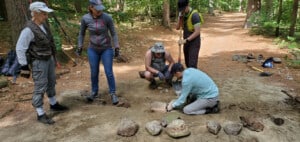
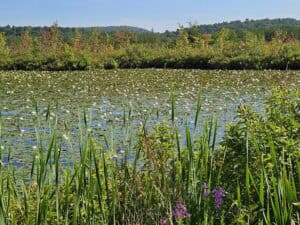
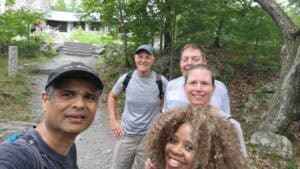
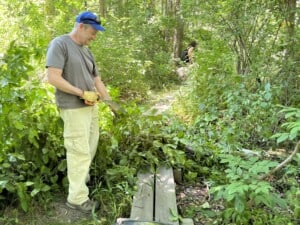

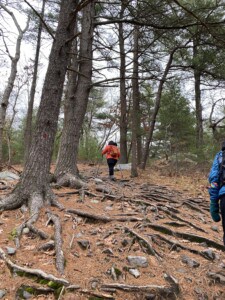



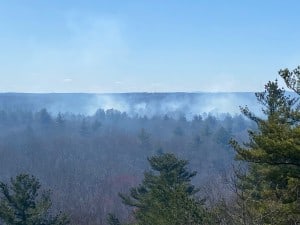
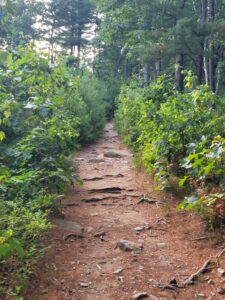
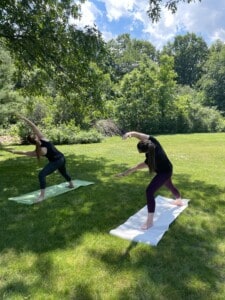
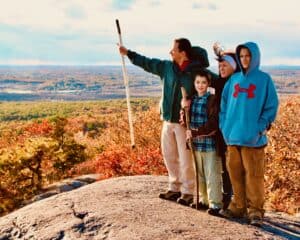
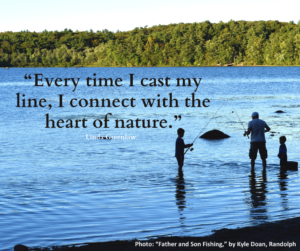

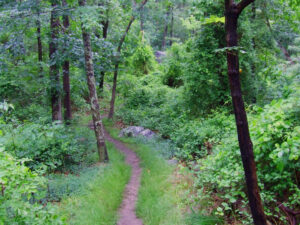
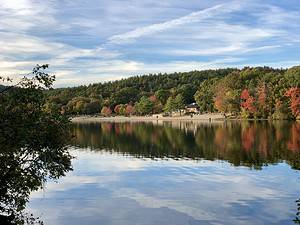

When hiking or anytime in the Blue Hills, PLEASE wear a mask and keep you distance from others on the trails. Most trails are NOT 6 feet wide, so you need to consider other hikers when you go out. I hate jumping into the trees to get off the trail when hikers without masks approach me on the trails.
Great comment!